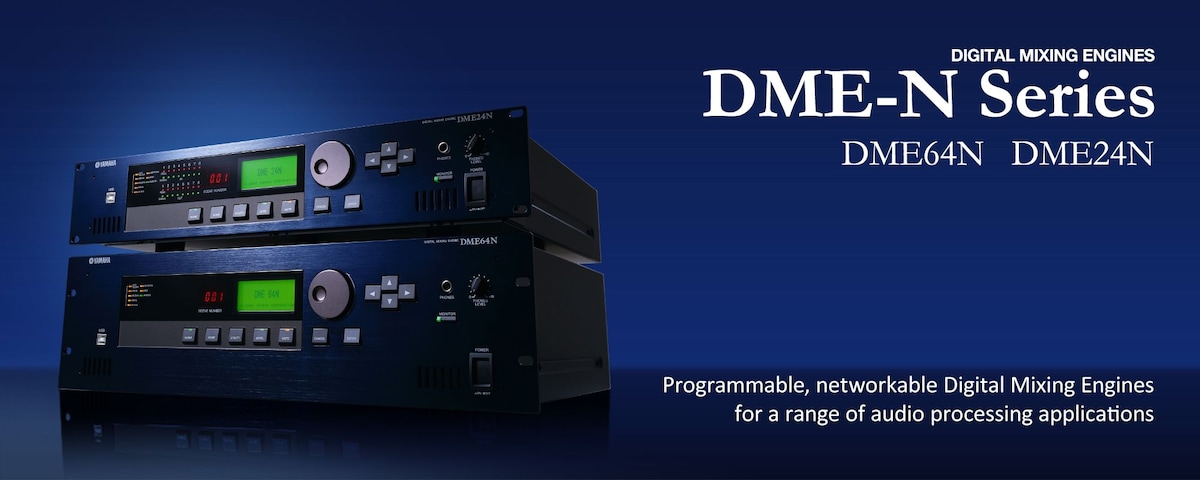DME24N, DME64N Digital Mixing Engine 단종
DME64N / DME24N Features
고급 디지털 믹서와 맞먹는 DSP 성능
DME64N과 DME24N에는 탁월한 오디오 처리 성능과 품질을 위해 야마하의 독창적인 DSP6 및 DSP7 신호 처리 LSI가 사용됩니다. DME64N은 야마하의 DM1000 디지털 믹싱 콘솔과 동등한 처리 성능을 제공하고, 그보다 작은 DME24N은 절반 정도의 처리 기능을 갖추고 있지만 작은 단순 시스템을 위한 내장 아날로그 I/O를 제공합니다. 어느 경우든지 단일 DME 장치를 중심으로 복잡한 시스템을 구축하고 콘서트 홀, 다용도 홀, 행사 공간, 기관 및 기타 광범위한 애플리케이션에서 최적의 성능을 발휘하도록 미세 조정할 수 있는 놀라운 처리 기능을 얻을 수 있습니다. 또한 풍부한 DSP 성능으로 인해 이전에는 여러 하드웨어 장치가 필요했던 고급 구성을 이제는 단 하나의 DME64N이나 DME24N에서 간편하게 실행할 수 있습니다. 따라서 DME 기반 시스템의 설계, 설치 및 운영에 필요한 시간, 에너지 및 비용이 크게 절감됩니다.
우수한 사운드를 제공하도록 설계된 24비트 96kHz 처리 및 회로
라이브 사운드와 스튜디오 레코딩 분야를 선도하는 전문가들이 야마하의 디지털 믹싱 콘솔을 선호한다는 사실은 더 이상 비밀이 아닙니다. 야마하의 DME 믹싱 엔진은 동일한 최첨단 오디오 기술을 활용하며 사운드와 연주를 진정으로 차별화하는 세부 사항에 주목합니다. DME64N과 DME24N 모두 최적으로 조정된 24비트, 96kHz 디지털 처리를 통해 결함 없는 정밀도와 재생 충실도를 제공합니다. 또한 DME24N에는 최고급 믹싱 콘솔과 동일한 사운드와 품질을 제공하는 고성능 아날로그 헤드 앰프가 있습니다. 참고: 48kHz 조작용으로 만든 구성을 실행하는 데 필요한 처리 성능은 96kHz 조작용으로 만든 구성의 절반입니다.
탁월한l I/O 유연성 및 확장성 - 최대 8개의 DME64N 장치(512개의 입력과 512개의 출력)까지 캐스캐이드로 연결
DME64N에는 Mini-YGDAI I/O 카드를 꽂을 수 있는 4개의 후면 패널 확장 슬롯이 있고 DME24N에는 하나의 확장 슬롯이 있습니다. 각 슬롯은 고정밀 A/D 또는 D/A 카드를 장착할 경우 최대 8개의 아날로그 입/출력을 지원하고 AES/EBU, ADAT 또는 TASCAM 형식에서는 최대 16개의 디지털 I/O 채널을 지원합니다. DME64N은 4개의 확장 슬롯을 통해 최대 64개의 I/O 채널을 지원할 수 있지만 DME24N에는 단일 슬롯과 8개의 내장 아날로그 I/O 채널(총 24개의 채널)이 있습니다. 대형 시스템의 경우 최대 8개의 DME64N 장치를 계단식으로 연결하여 512개의 디지털 입력과 512개의 디지털 출력 또는 128개의 아날로그 입력과 128개의 아날로그 출력을 대규모로 제공할 수도 있습니다.
PM5D 디지털 믹싱 콘솔과의 제어 통합

선별된 DME64N 및 DME24N 파라미터는 원활하고 효율적인 작업을 위해 PM5D 디지털 믹싱 콘솔로 직접 제어할 수 있습니다. 이 기능은 DME 장치가 최적의 감청 위치에서 벗어난 장소에 있을 경우에 특히 유용하며 메인 콘솔 위치를 떠나지 않고도 파라미터를 조정할 수 있게 해줍니다.
DME24N의 8개 아날로그 입/출력
DME24N은 후면 패널에 있는 유로블록 단자를 통해 8개의 내장 아날로그 입/출력을 제공합니다. 아날로그 입/출력에는 최고 등급의 오디오 성능을 전달하는 고정밀 24비트, 96kHz A/D 및 D/A 컨버터가 있습니다.
옵션형 MY16-CII 카드로 CobraNet™ 연결
RJ45 커넥터와 100Base-T CAT5 유형 이더넷 케이블을 통해 최대 16개의 DME64N, DME24N 및 ICP1 지능형 제어판 장치로 구성된 네트워크를 상호 연결할 수 있습니다. 이더넷 연결을 사용하면 최소한의 비용으로 빠르고 쉽게 제어 네트워크를 설정할 수 있습니다.
GPI, RS232C/RS422, USB 및 MIDI 인터페이스
DME64N과 DME24N 모두 광범위한 장비와 함께 사용할 제어 인터페이스에 대한 포괄적인 선택 항목을 제공합니다. DME64N에는 16개의 GPI 입/출력 단자가 있고 DME24N에는 8개의 GPI 입/출력 단자가 있어서 다른 GPI 장치 인터페이스와 손쉽게 연결할 수 있습니다. RS232C/RS422 포트를 사용하여 원격 제어 장치와 컴퓨터에 직접 연결하고 USB 포트를 사용하여 최신 컴퓨터에 직접 연결하며 MIDI 단자를 악기, 시퀀서, 조명 컨트롤러와의 동기화/제어에 사용할 수 있습니다.
포괄적 패널 컨트롤을 갖춘 LCD 디스플레이
읽기 쉬운 대형 LCD 디스플레이 패널과 포괄적인 패널 컨트롤 선택 항목을 통해 DME64N과 DME24N을 손쉽게 조작할 수 있습니다. 심지어 전면 패널에는 간편한 모니터링을 위한 헤드폰 잭과 레벨 컨트롤이 포함되어 있습니다. 또한 DME24N은 8개의 아날로그 입/출력에 대한 신호 및 피크 LED를 제공합니다.
5개 언어로 표시되는 SCENE 및 기능 이름
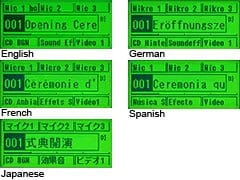
ICP1 지능형 제어판뿐 아니라 DME64N과 DME24N에서도 SCENE 및 기능 이름을 5개 언어(영어, 일본어, 프랑스어, 독일어, 스페인어)로 표시할 수 있습니다. 3개의 모델 모두 사용자에게 친숙한 인터페이스를 제공하므로 사용자의 기술이나 경험 레벨에 관계없이 매끄럽게 조작할 수 있습니다.
DME Components
Matrix Mixer
A number of matrix mixers with up to 64 x 64 matrix mixing capability are included. There's also a Delay Matrix Mixer that provides delay parameters for each matrix point, enabling level control and time alignment in a single convenient component.

Speaker Processing
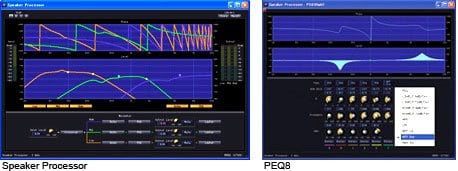
Speaker processing can be essential for achieving maximum performance from professional speaker systems as well as for delivering optimum sound quality throughout the listening area. DME processors include everything needed for precision speaker tuning and room matching: versatile crossover processors with APF (All Pass Filter for phase control), horn EQ, delay, limiter functions and more.
Room Combiner

The Room Combiner component adds multiple audio signals to "virtually" combine the acoustic spaces of multiple rooms. Mono and stereo components that combine 4, 8, 12, or 16 rooms are available. This component provides an effective solution for situations in which several rooms or areas can be physically partitioned or combined to handle different types of events or numbers of participants. Sources and outputs can easily be switched as required, and the processing for multiple areas can be handled by a single DME unit.
Auto Gain Control
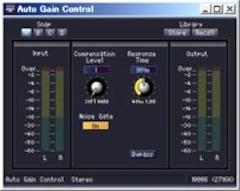
This function automatically adjusts gain to maintain a consistent level even if the volume of a speaker's voice varies, for example. An indispensable function for meeting rooms and conferences.
Auto Mixer
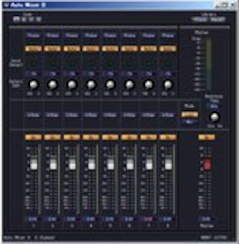
The Auto Mixer II component provides an over-ride function and automatic output level control make it possible to create "intelligent" systems that provide automated control for applications that don't require the presence of an experienced operator.
Program Ducker
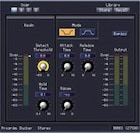
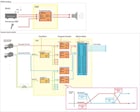
The Program Ducker component features significantly longer attack and release times. Mono and stereo types can be flexibly configured to accommodate a wide range of applications. The Program Ducker offers all the versatility required for installations ranging from banquet halls to theme parks, while additionally providing camera tally link capability for broadcasting - a field in which the DME series is finding increasing acceptance.The Program Ducker can be triggered from an oscillator. This makes it possible to use the output of a single oscillator to simultaneously trigger multiple channels for 5.1 surround, for example.
Ambient Noise Compensation(Version3)
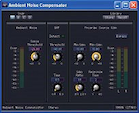
새 Ambient Noise Compensator 컴포넌트는 주변 노이즈 레벨을 측정하고 밸런스 및 지능성을 최적화하기 위해 프로그램 레벨을 자동 및 동적 방식으로 조정하는 데 사용할 수 있습니다. 이 기능은 예를 들어 주변 노이즈 레벨이 시간대나 특정 요일에 따라 급격하게 변화하는 쇼핑몰에서 안내 음성 레벨을 최적화할 때 유용합니다.
SPX
Yamaha SPX effects are recognized as being some of the best and most "musical" in the industry. In the DME processing engines you have full-featured SPX multi-effect processors that are on a par with those provided in top-line Yamaha production and live sound consoles.
Event Scheduler & Wav File Player
As their names imply the Wav File Player component plays specified Wav audio files, and the Event Scheduler can be used to trigger it at predefined times and repeating cycles. This could be used to play opening and closing themes for a retail outlet or mall, for example. Event Scheduler triggering is not limited to Wav File Player operation, however, and it could be used to schedule a GPI output that could start an external CD player or other device, for example. Programming the scheduler is easy, and can be done by the end user simple via wall-mounted remote control units or other remote controllers. Playback level and on/off switching can also be accomplished via the same type of controller.
V4 Features
Caution: The hardware specification for DME Firmware V3.5x or earlier differs from the one for Firmware V3.8x or later. Therefore firmware V3.5x or earlier cannot be upgraded to V3.81 or later (including V4.0). If you need to upgrade your DME from V3.54 or earlier to V3.81 or later (including V4.0), please contact your Yamaha dealer.
New Component of DME V4.0
음향 반향 제거기 구성 요소 (*이 구성 요소를 사용하려면 MY4-AEC 카드 필요)
이 새로운 구성 요소는 화상 회의에서 발생하는 어쿠스틱 에코를 줄이고 회의 및 대화를 위한 보다 우수한 음질을 제공합니다.
What's an Acoustic Echo?
In a teleconference, sound is exchanged in both directions through communication lines. When the voice of the person speaking in room A is transferred to room B through communication lines and reproduced by a loudspeaker, that voice can be heard in room B. However the microphone in room B also picks up the voice of the person speaking in room A and sends that voice back to room A. Because of this, in room A, the voice of the person speaking is reproduced by the loudspeaker as an echo. This is referred to as acoustic echo. In addition to hindering conversation, it can cause feedback. To have a smooth conference, it is necessary to reliably suppress acoustic echo.
Partial Recall

"With V4.0, Scenes now have a partial recall capability. So Scenes can be created that only recall one or more components
Configuration Replication
This function helps to reduce the time needed to create flexible control setups (MIDI / GPI / Remote Control Setup List) on multiple Scenes. If a Scene needs different MIDI or User Defined settings for example, then a new Configuration must be made. In V3.x, you need to duplicate the complete setup manually even if you want to change only a couple of parameters compared to the previous Configuration. Now there is a short-cut to replicate the configuration.


